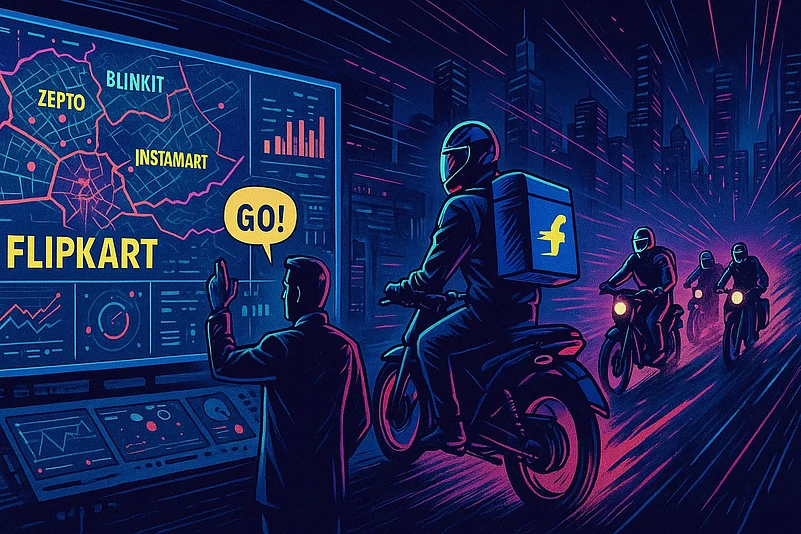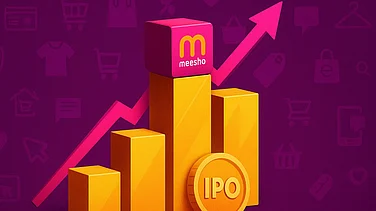While Flipkart Minutes may have been a late entrant to the quick commerce space, its pace of expansion has been remarkable, says Flipkart Minutes VP Kanchan Mishra. The company has already crossed the halfway mark of its 800 dark store target. “This is probably the fastest scale-up any quick commerce player in the country has achieved,” she adds.
Mishra highlights that one of Flipkart’s key advantages is its existing nationwide infrastructure. This includes a vast network of warehouses and a robust supply chain connecting cities across states.
“One of my favourite anecdotes,” she shares, “is about a customer in Guwahati who messaged Kalyan [Krishnamurthy] asking for quick commerce in the city. Within two months, we launched Minutes there. Today, we’re the largest commerce player in Guwahati. That’s how quickly we can go live in a new city.”
In a conversation with Outlook Business, Mishra addresses Flipkart Minutes’ strategy around scaling despite a late start, its pricing position between discounts and premiumisation, the potential of categories like large electronics in quick commerce versus traditional e-commerce, and more.
What are Flipkart Minutes’ expansion plans this year? Beyond metros, are Tier 2 and 3 cities also part of the focus?
We are now present in 19 cities, and our ambition is to hit the 800 dark store mark by the end of the year. We’re currently almost halfway through that journey.
Our expansion strategy is two-fold; it’s focused on intensifying our presence in metro cities and also tapping into the next wave of high-potential cities. We are already live in cities like Guwahati, Patna, Kanpur, Lucknow, Jaipur, and Ambala, to name a few, so we’ve already started building that footprint in Tier 2 and Tier 3 markets. And like I said, we are just halfway through our ambition for this year. As we continue expanding, we will keep tapping into more demand pockets.
Read: Flipkart Cofounder Binny Bansal Pumps $20 Mn into AI Start-Up 'ShopOS'
Do you have any specific timeline in mind?
While I can’t quote the number of cities specifically, we are gunning for around 800 dark stores by the end of this year. You can do the math; most of the quick commerce space has, until recently, been built on a roughly 1,000-store footprint. So that math takes you significantly beyond just 19 cities.
With many brands shifting ad spends from e-commerce to quick commerce, what’s Flipkart Minutes’ advertising strategy?
We have a very solid ad platform that actually enables our brands to spend across various channels on Flipkart, including the core platform as well as Minutes. The need to initially spend more on Minutes also comes from the fact that the entire cycle of a customer deciding to order on time, and the customer places an order on a channel like Minutes, is less than 5 minutes, right?
Brands want to be top-of-mind for customers, hence the need and the desire for brands to spend a lot to build that strong category association with the channel, so that they are top-of-mind. A customer will not spend a lot of time exploring when they are looking to place an order in 3 minutes. So that's where the top-of-mind becomes important, and hence you see a lot of brands wanting to build that association very, very deeply.
Read: Flipkart to Buy Back $50 Million in ESOPs, Benefiting at Least 7,000 Staff
Also, the typical scroll depths on a quick commerce channel are much lower. Customers scroll a lot less. So whatever appears right on top typically ends up winning customer basket share. Some of these make the tendency of brands to spend on quick commerce as a channel a lot stronger.
But the entire thing is powered by a very strong Flipkart ads tech platform that brings in a lot of insights on customer personalisation, on customer cohorts that brands want to go after and enables it in the process.
Will the broader grocery channel also move under the Minutes model, or do you still see value in same-day and next-day delivery?
I think we have seen that the consumption across the country is very diverse, with a diverse set of customers. So, same-day and next-day delivery continue to cater to a much larger audience. And quick commerce also has a separate audience. So for Flipkart, both are important, and that’s what we’re trying to work on.
Flipkart Minutes entered quick commerce relatively late, while others have already scaled with thousands of dark stores. What led to the delayed entry, and can you catch up at scale?
I think, while we may be slightly late to the party, I think our scale-up has been phenomenal. Like I said, we’ve already crossed the halfway mark of our 800-store ambition, which is probably the fastest scale-up that any quick commerce player in the country would have done.
And what we see playing beautifully to our strength is, like I’ve said already, the fact that our time to scale up is not long. We already have Flipkart’s infrastructure across the country, in terms of multiple warehouses that we have across every state, serving it, the kind of supply chain capabilities that we have connecting various cities in the country.
My favourite anecdote to share is a customer from Guwahati actually pinged Kalyan and said, “We don’t have quick commerce in Guwahati yet. Can you please launch quick commerce in Guwahati?” And within 2 months, we were able to launch Minutes in Guwahati. And interestingly, we are now the biggest commerce player in Guwahati. So, our time to launch a city is very, very fast.
We’ve been expanding and doubling our orders per day every 45 days, which is a phenomenal growth trajectory. And the strength of Flipkart tech, the strength of the Flipkart supply chain, coupled with the fact that we already have a very strong, captive, loyal base of Flipkart customers, makes our journey to scale up a lot faster. So, we are confident that our journey of scale-up is going to be a lot faster, and we continue to see the proof of that.
Just adding to that, I think the fact that our infrastructure is already there in place, so when we did our next-day delivery, same-day delivery services, we saw an uptake. So I don’t think, for us, it’s like a race to get into the quick commerce space. It was more of a customer demand, that, you know, there is an appetite for 10-minute delivery, and it’s not just limited to one city or two cities. So I think there was a lot of insight that was sitting with the team, and that’s when we decided okay, there is demand, there is a need to now go live in different markets. Today also, if you see, we’re live in 19 cities based on the demand and tomorrow, if there is a demand for more, we’ll do more, because the infrastructure exists with Flipkart. So whenever our customers tell us that they need quick commerce, we’ll scale there. And our journey to scale up is very, very quick.
On the logistics front, is Flipkart Minutes relying more on dark stores or Kirana tie-ups? What does the model look like for you?
We have micro-fulfilment centres. And while for the larger eKart network, we work closely with Kiranas, we are still in the process of figuring out how to integrate them into the larger quick commerce world as well. But we work through micro-fulfilment centres that get supplied by our larger Flipkart fulfilment centres, where we serve various kinds of products from D2C brands, sellers, and so forth.
The strength that we bring to the table is, Flipkart has an active working relationship with a very wide set of brands and sellers. And by virtue of that, most of these brands anyway supply to our fulfilment centres or the larger Flipkart ecosystem. And hence, our ability to bring selection from our warehouses to our micro-fulfillment centres is a lot more flexible and agile than the larger quick commerce world. And hence, if you see, we’re already working with more than a hundred D2C brands and exposing their assortment to customers.
So, that journey for us is a lot more seamless, because we can just tap into the larger Flipkart warehouses, bring in selection, expose the selection to our customers, give the feedback loop back to our brands on what’s working, what’s not working, and trade with them continuously.
What’s Flipkart Minutes’ pricing strategy—deep discounts or premiumisation? Where do you see yourself positioned?
We endeavour to bring convenience to our customers while keeping the essence of affordability and sustainability alive. And, the fact that we have a lot of shared infrastructure with Flipkart, makes our cost of fulfillment a lot more effective than the rest of the quick commerce. Most of our warehouses are shared with Flipkart. So, we are not investing additional capital expenditure to build more infrastructure. Most of our delivery runs from warehouses to our stores are shared with Flipkart. That makes our cost of fulfillment and cost of serving our customers a lot more effective.
The second thing is, we have a massive base of extremely loyal customers at Flipkart which also makes our cost of customer acquisition a lot more effective. And we intend to pass on the benefit that we achieve from shared supply chain infrastructure and effective cost of customer acquisition back to our customers, so that they find convenience while finding it affordable and sustainable as well.
How about premiumization?
Just by the nature of the customers that come to quick commerce, there is an inherent bias towards premier and affluent customers being the more convenience-seeking kind of customers.
There is this term that some of the consulting reports call, uh, as “California customers”. Because their purchasing power has historically represented the purchasing power of customers in Silicon Valley and California, right?
So, this sort of customer has an inherent bias to adoption of quick commerce, and that shows in our demand patterns and our customer adoption patterns as well, where customers who are coming onto quick commerce are also looking for more premium products, on a relative basis. And that shows in the assortment that we bring to our customers as well.
Fortunately, we have a very strong tech backbone that powers a lot of these insights, and hence, we are able to bring in the right kind of selection to the right kind of customers. So, there's definitely a bias towards it. But as you see, where will quick commerce growth come from here on, right? You will also see a lot of your non-California customers starting to come into the quick commerce frame.
Quick commerce penetration has been low single digits so far, despite all that we have achieved. And as quick commerce expands, more of your non-California customers are supposed to come into the frame, because that's where the majority of India's retail market lies.
I think there’s a Bain report that you can refer to that they released this year, which talks about where the size of the retail pie lies. And in light of that, the next wave of customers that will come onto commerce are expected to be more value-centric as well, right? And that is what we also see playing in, because we are expanding the market.
So, we clearly see a very good mix of premium customers coming into the fray, and a very good mix of value-centric customers coming into play.
Grocery fits quick commerce naturally, but what about fashion and electronics—categories Flipkart is strong in? Given your access to space, are you approaching category selection differently for habit creation?
So, while grocery and essentials continue to be the core of quick commerce, by virtue of the nature of the category. I mean, you see a lot of veggies, you see a lot of indulgence categories like ice creams, munchies, your typical stock-up categories like atta, travel, oil, run through quick commerce and that continues to be the core.
We also believe that, for what we call the “California customer,” which is well-entrenched in quick commerce, the expansion is going to come by moving more of their share of wallet onto quick commerce, right. And this expansion of share of wallet onto quick commerce comes by virtue of the categories that Flipkart has a very strong hold on, like beauty, personal care, grooming, fashion, and electronics. And we have seen a very clear trend on this. Our Gen Z customers, for example, love to experiment with trendy electronics. And a lot of these purchases are last-minute. Especially in the evenings, we see a good spike between 6pm to 9pm, happening in trendy electronics purchases.
Fashion has shown a tremendous spike for us, especially when it comes to occasions like Father’s Day, where gifting categories like watches, wallets have witnessed a spike. A very interesting use case of metro customers looking for badminton shoes over the weekend, because they are going out for sporting occasions with friends and family. So, a lot of these play beautifully to our strengths, and we continue to bring it.
Actually, recently, we also launched product exchange as a capability in limited PIN codes for our customers, which adds to our strength of bringing in electronics to customers from a last-minute use-case perspective. Especially when you think of cases like “I dropped my phone” or “My phone got wet because it was raining outside,” and suddenly, I’m in need of a phone replacement quickly. We serve customers with a product exchange capability that gives them good value for their defunct phone and gives them a replacement within an end-to-end order-to-delivery time of 40 minutes. So a lot of these play very well to our strengths.
In summer, for example, if you look at categories which are summer-centric, like sunscreen, anti-tan, they saw a 1.6x to 2x spike for us. In monsoons, when you look at categories like anti-frizz or categories like antibacterial skin solutions, they’ve seen a 4x to 2x sort of spike, depending on the category. So, these play beautifully to Flipkart as a strength. They help us increase the share of wallet of an entrenched Flipkart customer onto Minutes as a platform. They also help us increase the stickiness of that customer on Flipkart overall as a platform.
Do you think large electronic items or extremely costly items, for that matter, can ever be a quick commerce category, or will it continue to be an e-commerce category?
There is a cost angle to it, and there is a volumetric bulky angle to it. For cost, we've sold mobile phones upwards of a lakh as well. We've been exclusive launch partners for a lot of premium handsets. So, costly goods, of course, we've sold gold, gold coins, etc., be it on Nakshatra or be it on Dhanteras. So, costly goods, absolutely.
Volumetric could be a challenge because of the nature of the supply chain, right? Most of the deliveries happen on bikes, which are not conducive to bulky deliveries. But we've also seen bulky-enough deliveries happen on quick commerce. We've sold massagers on quick commerce which are bulky enough. We've sold geysers on quick commerce, which are again reasonably bulky. So, bulky-enough categories, yes. The most bulky of categories, like refrigerators and washing machines, I think, the supply chain will have to evolve a little bit as we get to that.



























